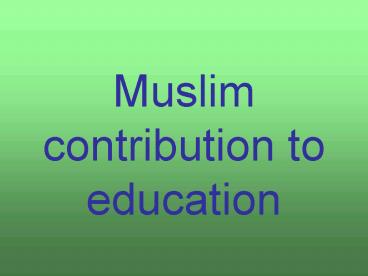Muslim contribution to education - PowerPoint PPT Presentation
1 / 11
Title:
Muslim contribution to education
Description:
'It will suffice here to evoke a few glorious names without ... Algorism, Algorithm. Al-Khawarizmi. Geber. Jabir Ibn Haiyan. Latinized/English Name. Arabic Name ... – PowerPoint PPT presentation
Number of Views:784
Avg rating:3.0/5.0
Title: Muslim contribution to education
1
Muslim contribution to education
2
Testimony of the orientalists
- ? ????? ?? ???? ?? ???????
3
George Sarton's tribute to Muslim Scientists in
the "Introduction to the History of Science
- "It will suffice here to evoke a few glorious
names without contemporary equivalents in the
West Jabir ibn Haiyan, al-Kindi, al-Khwarizmi,
al-Fargani, al-Razi, Thabit ibn Qurra,
al-Battani, Hunain ibn Ishaq, al-Farabi, Ibrahim
ibn Sinan, al-Masudi, al-Tabari, Abul Wafa, 'Ali
ibn Abbas, Abul Qasim, Ibn al-Jazzar, al-Biruni,
Ibn Sina, Ibn Yunus, al-Kashi, Ibn al-Haitham,
'Ali Ibn 'Isa al-Ghazali, al-zarqab, Omar
Khayyam. A magnificent array of names which it
would not be difficult to extend. If anyone tells
you that the Middle Ages were scientifically
sterile, just quote these men to him, all of whom
flourished within a short period, 750 to 1100
A.D."
4
John William Draper in the "Intellectual
Development of Europe"
- "I have to deplore the systematic manner in which
the literature of Europe has continued to put out
of sight our obligations to the Muhammadans.
Surely they cannot be much longer hidden.
Injustice founded on religious rancour and
national conceit cannot be perpetuated forever.
The Arab has left his intellectual impress on
Europe. He has indelibly written it on the
heavens as any one may see who reads the names of
the stars on a common celestial globe."
5
Robert Briffault in the "Making of Humanity"
- "It was under the influence of the Arabs and
Moorish revival of culture and not in the 15th
century, that a real renaissance took place.
Spain, not Italy, was the cradle of the rebirth
of Europe. After steadily sinking lower and lower
into barbarism, it had reached the darkest depths
of ignorance and degradation when cities of the
Saracenic world, Baghdad, Cairo, Cordova, and
Toledo, were growing centres of civilization and
intellectual activity. It was there that the new
life arose which was to grow into new phase of
human evolution. From the time when the influence
of their culture made itself felt, began the
stirring of new life.
6
W. Montgomery Watt, Islamic Surveys The
Influence of Islam on Medieval Europe Edinburgh,
England 1972 p.84
- . "Because Europe was reacting against Islam it
belittled the influence of Saracens Muslims and
exaggerated its dependence on its Greek and Roman
heritage. So today an important task for us is to
correct this false emphasis and to acknowledge
fully our debt to the Arab and Islamic world".
7
Latinised names of Muslim scholars
8
Setting the record straight!
9
- What is Taught The first mention of man in
flight was by Roger Bacon, who drew a flying
apparatus. Leonardo da Vinci also conceived of
airborne transport and drew several prototypes. - What Should be Taught Ibn Firnas of Islamic
Spain invented, constructed and tested a flying
machine in the 800's A.D. Roger Bacon learned of
flying machines from Arabic references to Ibn
Firnas' machine. The latter's invention antedates
Bacon by 500 years and Da Vinci by some 700 years.
10
- What is Taught Glass mirrors were first produced
in 1291 in Venice. - What Should be Taught Glass mirrors were in use
in Islamic Spain as early as the 11th century.
The Venetians learned of the art of fine glass
production from Syrian artisans during the 9th
and 10th centuries.
11
- What is Taught Isaac Newton, during the 17th
century, discovered that white light consists of
various rays of colored light. - What Should be Taught This discovery was made in
its entirety by al-Haytham (11th century) and
Kamal ad-Din (14th century). Newton did make
original discoveries, but this was not one of
them.































